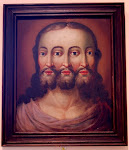I heard this story from a Jesuit professor some months ago. This is a true story.
In the 1980s, a newly ordained Jesuit was sent to minister to the people of Barangka, a tiny barangay in the city of Marikina. Now, Barangka wasn't really the wealthiest of places; in fact, it is quite small, cramped, and a bit dirty. The people there were mostly blue collar types who enjoyed the simple things in life. The Jesuit was warmly received by his new parishioners, despite the fact that he was, for all intents and purposes, practically a high-born aristocrat who did not really speak Tagalog very well.
Months after the new priest had settled into his parish, one particularly stormy afternoon revealed to him the dilapidated state of the parish he served. And since the parish was located in Marikina-- one of the most flood-prone areas in all of Metro Manila-- he was impelled to do something, lest the church crumble eventually. And so the Jesuit headed to his convento, a small and rather old structure that simultaneously served as the parish hall, the rectory, and the sacristy. There was a porch and a small garage at the first level of the convento (the priest's living quarters and office were located on the second floor, apparently), and in that sorry area was a small, tattered, wooden desk. Its varnish had all but faded and its edges betrayed none of the skill of the craftsmen that made it. Once, when the secretary was away on an errand, the newly ordained priest checked to see his secretary's log book to check if there were any appointments for the day.
Seeing none, he thought of replacing the log book in the drawer; but a sudden glint of brightness, like sunshine struggling to escape a dark and foetid cave, struck his eye. And so he pulled the drawer forward; what he saw next shocked him. It was a pyx, a rather big one at that. Though it seemed to have lost some of its luster, there was no denying the quality of its craftsmanship. The Jesuit weighed the golden pyx, finding it heavy. More remarkable, though was that its edges were studded in diamonds-- real diamonds, the kind that could very easily make it a target for thieves.
Eventually the secretary came back, and the curious Jesuit asked her if she had known that the pyx had been there all along. She replied in the positive, saying that his (the Jesuit) predecessors thought of hiding it in plain sight. She explained that the pyx had been with the parish for twenty years, and that it had been loaned to them by the Jesuits of the Ateneo de Manila, as a token of that Order's friendship with their community.
'Would you like to see the monstrance now, Father?'
As if the discovery of that pyx had not been enough, there was apparently a bigger surprise awaiting the Jesuit. The elderly secretary led him to an old, dusty part of the convento that was little used; the Jesuit himself, who was a professor of philosophy at the Ateneo, would often hie off to the university and spent little time in the convento. She pointed to an old, ratty looking closet that smelt like naphthalene and whose wood had practically rotted; opened it, and showed their new parish priest its contents. And what a beautiful sight it was!
Inside the closet, partially obscured by some old chasubles, was a thing fit for a king. It was a monstrance, some three or four feet tall, made of the purest gold. Though it too seemed to have warranted more than a few swabs to restore some of its sheen, it was unmistakably, undeniably golden, a baroque fantasy with a sunburst nearly a foot high. The rays of the sunburst were studded with diamonds, rubies, and emeralds. It was a mind-boggling sight, and the irony of its being contained in such a space was exceedingly great; the Jesuit estimated it to have weighed ten pounds at the very least. There was no doubt in his mind that the monstrance, at the current market value then, would have sufficed to buy a house in one of Manila's wealthier subdivisions.
'Do you want it back, Father? The Jesuits said we could use it as long as we want; but there's hardly benediction anymore, and I'm not sure how long we can keep this up. It is rightfully yours, anyway, so if you want to take it back, we are okay with it.'
The Jesuit took her up on her offer, and carted the monstrance back to the Ateneo the next day.
* * *
Today, years after that incident, the Jesuit recalls how the monstrance mysteriously vanished. When he had brought it back from his humble Barangka parish, he entrusted it to the Loyola House of Studies; the seminarians apparently stored it in some vault, to be used only at important occasions. One time, the Jesuit, who still teaches philosophy today, suddenly remembered the incident of the monstrance. In Santa Ana, a suburb of Manila, a house run by the Jesuits for its elderly members was in danger of collapsing, partly from age, and partly from neglect. A suggestion came out that pushed for selling the house. The Jesuit thought that the monstrance, which was already worth millions in the eighties, would be able to solve their conundrum if sold.
Curiously, no one among the seminarians and even his fellow Jesuits seem to have remembered where they put it. One of them suggested opening a particular vault; but there was nothing inside. Sadly, it seems as if this monstrance, which had been very little used, even in the 1960s, has been consigned to the dustbins of memory.
















